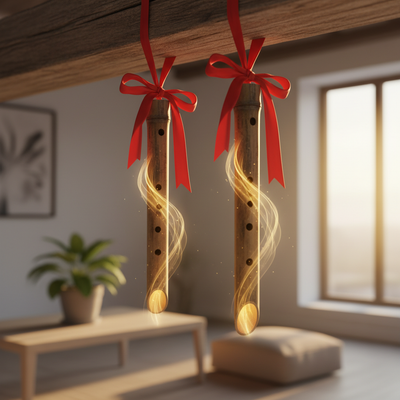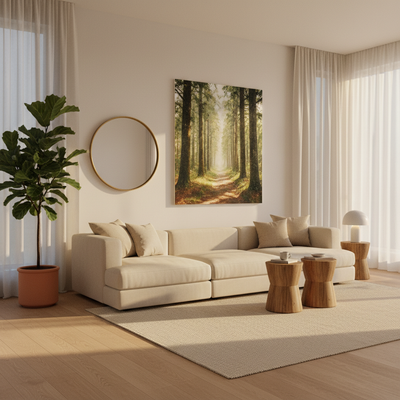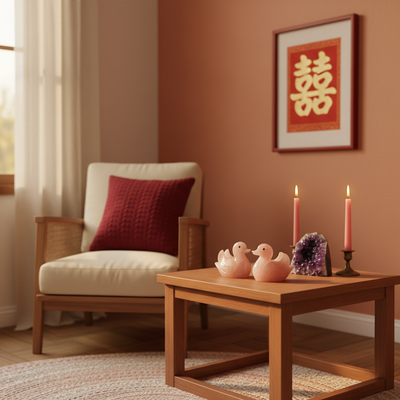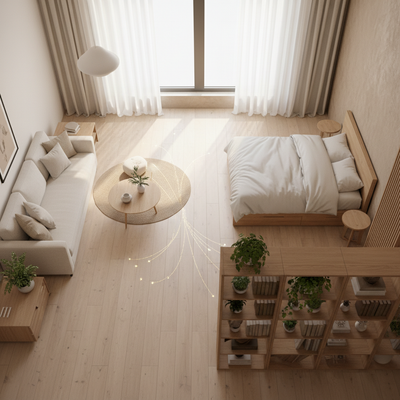From Awkward to Amazing
Living with a small bedroom is challenging. Living with a small bedroom that has an awkward layout is even harder. That L-shaped corner, the slanted attic ceiling, or the door that seems to be in the worst possible spot can leave you feeling stuck, frustrated, and cramped. You've probably looked for feng shui tips, only to find advice that assumes you have a perfect, rectangular room with plenty of space.
This is not that guide.
We understand that basic "feng shui 101" doesn't work when you're dealing with strange room shapes and limited square footage. This guide is designed for your reality. We will provide clear, step-by-step solutions made for these specific awkward situations. It's time to stop fighting your room and start working with it to create a space that feels supportive, restful, and energetically balanced.
Essential Feng Shui Basics

Before tackling specific layouts, we must establish the core principles. Think of this as your essential toolkit. Understanding the "why" behind these concepts will help you apply them smartly in any small, challenging space.
The Commanding Position
The commanding position is the most important principle for a bedroom. It means you can see the door from your bed without being directly in line with it. This placement taps into a basic need for security, allowing your nervous system to fully relax because you can see who or what is entering your space. When you can't see the door, you remain in a state of low-level stress, which disrupts restful sleep.
But what if your small room makes the "perfect" position impossible? This is a common problem. The goal is to get as close as possible. Even a partial view of the door is better than none. A simple fix is to place a small, well-secured mirror at an angle that allows you to see a reflection of the doorway from your bed. We often see clients who feel on-edge in their bedroom, and it's almost always because their bed placement leaves their back to the door. The simple act of moving the bed, even just a few feet, can dramatically change how the entire room feels.
Understanding the Flow of Qi
In feng shui, Qi (pronounced "chee") is the vital life force energy that flows through all things, including your home. Imagine it as a gentle stream. In a well-designed space, Qi moves softly, nourishing everything in its path. An awkward small bedroom layout, however, creates an obstacle course.
Sharp corners from walls or furniture create "poison arrows" that cause Qi to speed up aggressively. Narrow pathways between the bed and the wall can cause it to become stuck, leading to stagnant Qi. This results in feelings of tiredness and being stuck in life. A long, narrow room can create rushing Qi, making the space feel chaotic and unsettled. Your goal is to guide the Qi so it flows smoothly and evenly throughout the entire room.
The Power of Decluttering
For a small space, decluttering is not just a chore; it is your most powerful feng shui action. Clutter is more than just physical stuff. It is stagnant energy that blocks the flow of Qi, weighs you down emotionally, and prevents new opportunities from entering your life. In a small bedroom, its effect is amplified.
Here is a simple plan to reclaim your space:
- The Under-Bed Space: Your first task is to clear everything from under your bed. This space needs to be open to allow energy to circulate freely around you while you sleep. Storing items here, especially those with emotional or chaotic energy (like old papers or shoes), directly impacts your subconscious.
- The Surface Sweep: Clear all surfaces—your nightstand, dresser, and any shelves. Leave only what is absolutely essential or genuinely beautiful. This single act creates an immediate sense of calm and visual space.
- The 'One In, One Out' Rule: To maintain this clarity, adopt a new habit. For every new item that comes into the bedroom, one item must go out. This prevents the slow creep of clutter from returning.
What to Remove Immediately
- Work-related materials (laptops, documents)
- Exercise equipment
- Televisions
- Dead or dying plants
- Too many books or magazines
- Anything broken or unused
- Clutter from under the bed
Understanding Your Awkward Layout
To find the right solution, you must first accurately identify your problem. Most challenging small bedrooms fall into one of several common categories. Recognizing your room's type moves you from a feeling of "my room is just weird" to "I have a specific layout challenge with a clear solution."
Common Awkward Layouts
- The L-Shaped Room: The room has a distinct nook or alcove, creating a "missing" corner from a standard rectangular shape. This often creates a sharp interior corner.
- The Long, Narrow "Corridor" Room: The room's length is dramatically greater than its width, making it feel more like a hallway than a restful chamber.
- The Slanted Ceiling / Attic Room: The ceiling slopes down on one or more sides, creating a sense of pressure and limiting usable wall space.
- The Room with Many Doors/Windows: Multiple entry and exit points for energy (including closets) can make the room feel scattered, ungrounded, and lacking a secure place for the bed.
- The Off-Center Door/Window Room: The main entry or a large window is placed awkwardly to one side, throwing off the symmetry and balance of the entire space.
Step-by-Step Feng Shui Solutions
This is the heart of your transformation. Here are targeted, actionable solutions for each of the awkward layouts identified above. Find your room type and follow the plan.
Solution for The L-Shaped Room
This layout presents two main challenges: the "poison arrow" from the inner corner and the awkward, often-unused nook.
- Problem: The 'Cutting' Corner. The sharp interior corner of the "L" directs aggressive energy.
-
Solution: Soften it. Place a tall, leafy, upward-growing plant (like a Fiddle Leaf Fig or Snake Plant) in this corner. The organic shape and living energy will diffuse the sharpness. Alternatively, place an uplight on the floor to shine light up the corner, lifting the energy and visually dissolving the hard edge.
-
Problem: The Awkward Nook. The alcove can feel disconnected and often becomes a dumping ground for clutter.
- Solution: Give it a purpose. You must define this space. Turn it into a quiet reading corner with a small, comfortable armchair and a lamp. Make it a meditation spot with floor cushions and a small altar. Place a slim desk there if you must have a workspace, but be sure to cover it with a beautiful cloth when not in use. By assigning a clear, positive function, you integrate the nook into the room's energy field.
Solution for The "Corridor" Room
The primary goal in a long, narrow room is to slow down the rushing Qi and create a visual illusion of width.
- Bed Placement: Avoid placing the bed at either far end of the room, as this puts you directly in the path of the rushing energy. Instead, position the bed against one of the long walls, ideally in the commanding position relative to the door.
- Break It Up: Use a small, circular or oval rug in the center of the room or under the front half of the bed. The rounded shape acts as a gentle energetic "stop," encouraging Qi to pool and meander rather than shoot straight through.
- Widen with Mirrors: Place a large mirror on one of the long walls. This is a classic technique to create an immediate illusion of width and depth. The crucial rule is to ensure the mirror does not reflect your bed, as this can disrupt sleep. It should reflect a window or a beautiful piece of art if possible.
| Do's and Don'ts for a Narrow Bedroom | |
|---|---|
| DO | Use a rug to define a central zone. |
| DON'T | Line up all furniture against one wall like a bowling alley. |
| DO | Paint the two short end walls a slightly darker shade to make them advance visually. |
| DON'T | Use vertical stripes, which will accentuate the height and narrowness. |
| DO | Place furniture (like a slim dresser) on the opposite long wall from the bed to create balance. |
| DON'T | Leave a long, empty path from the door to the far wall. |
Solution for Slanted Ceilings
An attic room or a room with a slanted ceiling can feel oppressive, literally weighing down on you as you sleep. The feng shui cure is to lift the energy and counteract the downward pressure.
- Bed Placement is Key: This is non-negotiable. Always place your headboard against the tallest vertical wall in the room. Never, ever sleep with your head directly under the lowest point of the slant. This creates constant energetic pressure that can lead to headaches, poor sleep, and a feeling of being constrained in life.
- Paint it Light: Paint the slanted portion of the ceiling a light, bright color—ideally a shade or two lighter than the walls. White is excellent. This creates an optical illusion, making the ceiling feel higher and recede.
- Uplighting: This is a powerful and simple cure. Place one or two floor lamps or canister lights that shine light upwards onto the slanted ceiling. This act of shining light up visually and energetically "lifts" the oppressive weight of the ceiling.
Solution for Many Doors or Windows
When a room has multiple doors (including closet doors) and windows, the Qi can become chaotic and leak out too quickly, making it difficult to feel secure and grounded. The goal is to anchor the energy.
- Ground the Bed: In a room like this, a solid, tall, and preferably upholstered or wooden headboard is essential. It acts as a mountain at your back, providing a sense of stability and support amidst the energetic "leaks" from the various openings.
- Minimize Energy Leaks: Use substantial window treatments like layered curtains or solid blinds, and keep them closed at night to contain the room's energy. Keep the doors to closets and en-suite bathrooms closed whenever they are not in use.
- Block Unused Doors: If you have a door you never use (e.g., a second entry or one to a Jack-and-Jill bathroom), block it off energetically. You can place a beautiful folding screen, a tall bookshelf, or even a large plant in front of it. This tells the Qi that this is no longer an active exit.
For truly complex situations with multiple doors creating conflicting energy flows, a personalized consultation can be invaluable. The THE QI FLOW team often tackles such challenges by creating a custom Bagua map to identify the most auspicious sector for the bed, and then uses specific elemental cures to harmonize the remaining doors, turning a chaotic room into a serene sanctuary.
Solution for The Off-Center Door
When a door is placed far to one side, it can make the entire room feel lopsided and unbalanced. Your task is to energetically "re-center" the space using furniture and decor.
- Create a Counter-Weight: The key is balance. If the door is on the far-left side of a wall, you must add visual and energetic weight to the far-right side of the room. Place a significant piece of furniture, like a dresser, a chest of drawers, or a comfortable armchair with a floor lamp, on the opposite wall. This creates a pleasing sense of equilibrium.

- Use Art as an Anchor: Draw the eye away from the awkward door placement by creating a new, intentional focal point. A large, compelling piece of art or a well-curated gallery wall placed in the center of the main wall can effectively become the room's new anchor, making the door's position feel less significant.
Case Study: A 10'x8' Attic Room
Theory is helpful, but seeing it in action is transformative. Let's walk through a real-world example of a small, awkward attic bedroom and how these principles were applied.
The 'Before': Cramped and Unsettling
The room was a classic attic challenge. The bed was pushed into a corner, with the head directly under the lowest part of the slanted ceiling. A small window and an awkwardly placed off-center door made furniture placement a nightmare. The one corner with full-height ceilings was filled with boxes and clutter. The client described the room as feeling "heavy," "draining," and "unsettling," and reported frequently waking up tired.
- Slanted ceiling created oppressive energy over the bed.
- The bed was not in the commanding position.
- Stagnant Qi was trapped in the cluttered corner.
- The off-center door created an unbalanced feeling.
The 'After': Applying the Fixes
We made a series of simple, targeted changes based on the principles in this guide.
- Repositioned the Bed: The first and most critical change was moving the bed. We placed it against the only full-height wall, which instantly put the client in a commanding position with a clear view of the door.
- Lifted the Ceiling: The slanted ceiling and walls were painted a bright, soft white. We then placed a simple uplight in the corner, washing the ceiling with light and making it feel dramatically higher.
- Balanced the Door: The clutter was cleared from the high-ceilinged corner. On the wall opposite the off-center door, we placed a slim, tall bookshelf, which served as a visual counterweight and provided needed storage.
- Added a 'Cure': A small, round mirror was strategically placed on the wall to the side of the bed. It didn't reflect the bed but instead reflected the light from the window, visually expanding the space and pulling more light into the room.
The shift was immediate. The client reported sleeping more deeply within the first week and feeling a sense of calm and control in their space for the first time. It no longer felt like an awkward attic, but a purposeful, cozy retreat. This proves that no space is a lost cause.
Beyond Layout: Advanced Solutions
Once your furniture is placed correctly, you can use more subtle tools to fine-tune the energy of your feng shui awkward small bedroom layout. Color, light, and mirrors are not just decorative; they are powerful feng shui cures.
Using Color and The Five Elements
In feng shui, the Five Elements—Wood, Fire, Earth, Metal, and Water—are the building blocks of everything. Each has corresponding colors, shapes, and materials. You can use them to correct imbalances in your room.
| Problem | Element to Add | Colors & Shapes to Use |
|---|---|---|
| Room feels oppressive (slanted roof) | Wood | Greens, light blues; tall, columnar shapes (tall lamp, tall plant, vertical stripes). |
| Room feels chaotic (many doors) | Earth | Earthy tones (yellow, beige, sandy brown); square shapes (solid square rug, square art). |
| Room feels stagnant (L-shape nook) | Metal | Whites, grays, metallics; circular shapes (round side table, round mirror, metal decor). |
| Room feels narrow and rushing | Metal | Whites and pastels to widen. Add Earth elements (a square rug) to ground and slow the energy. |
The Strategic Use of Mirrors
Mirrors are the "aspirin" of feng shui—they can solve many problems, but must be used correctly.
- Use a Mirror to:
- Visually expand a narrow room by placing it on a long wall.
- Pull the energy of an outdoor view inside (reflecting a garden or trees).
- Activate a "missing" corner in an L-shaped room by reflecting the main space into it.
-
Allow you to see the door from the bed if you cannot achieve the commanding position.
-
Never Use a Mirror to:
- Reflect the bed. This is believed to invite a third party into the relationship and can disrupt sleep by doubling the energy in the room.
- Directly face the bedroom door. This pushes all the good energy right back out of the room.
- Reflect clutter, another door, or anything unpleasant, as it will double that negative energy.
Lighting as a Powerful Tool
Layered lighting is essential in any room, but it's a game-changer in a small, awkward one. A single, harsh overhead light creates shadows and emphasizes flaws.
- Uplights for Low Ceilings: As seen in the case study, shining light upward visually lifts a low or slanted ceiling.
- Define Zones: Use a specific light for a specific purpose. A soft reading lamp in your reading nook, a gentle lamp on your nightstand. This helps define the different functional areas of your room.
- Soften Corners: Place a small lamp on the floor or a table in a dark, sharp corner to soften it and prevent Qi from stagnating there.
- Install Dimmer Switches: This is one of the best and cheapest upgrades for a bedroom. It gives you complete control over the energy, allowing you to have bright, clear light when needed and soft, calming, yin energy as you prepare for sleep.
Your Bedroom is Full of Potential
Your small, awkward bedroom is not a problem to be endured; it is a space of potential waiting to be unlocked. By understanding the flow of energy and applying these targeted cures, you can transform any room—no matter the shape or size—into a sanctuary that supports your well-being, promotes restful sleep, and feels like a true reflection of you.
Don't feel overwhelmed. Start with one small change. Clear the clutter from under your bed. Move a lamp into a dark corner. Reposition your bed six inches. The journey from awkward to amazing begins with a single, intentional step. You have the power to reshape the energy of your most personal space.







